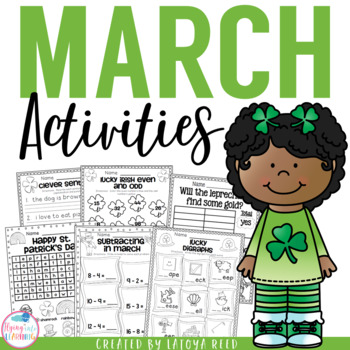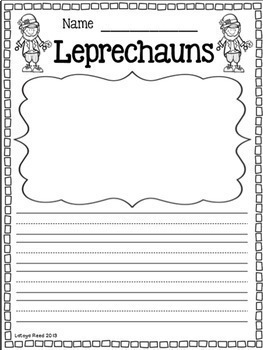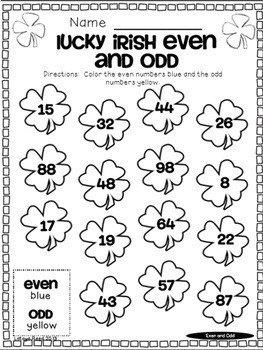- PDF
Description
This packet contains all the St Patricks Day Activities practice you need for the month of March to review Common Core ELA and Math skills. It can be used for morning work or classwork. There are 40 pages included to make your life much easier. Just print and go! I have included a bonus Leprechauns mini unit. Enjoy and thanks for your support! Don't forget to follow my store for updates and freebies!
Check out the money saving bundle of all of my printables here
DOWNLOAD PREVIEW TO SEE MORE PAGES IN THE UNIT !!!
St Patricks Day Activities ELA Skills (13 pages)
Editing Sentences
Long and Short Vowels Sort
CVC Words
Beginning Blends
Digraphs
Syllables
Silent E/Long Vowels
Uppercase/Lowercase Letters
ABC Order
Compound Words
Color Words
Beginning Sounds
Word Families
St Patricks Day Activities Math Skills (16 pages)
Addition Doubles
Missing Addends
Fractions
Tens and Ones
Even and Odd
Fact Families
Writing Numbers to 100
Time to the Hour and Half Hour
Graphing
Addition to 18
Subtraction to 18
Comparing Numbers
Counting by Tens
Skip Counting by 2's, 5's, and 10's
Ten More, Ten Less, One More, One Less
Shapes
St Patricks Day Activities Leprechauns Mini Unit (12 pages)
Double Bubble comparing elves and leprechauns
Spelling Words
Making Words
Leprechauns are, can, have
Bubble Map
Circle Map
Writing Paper with picture space
Writing paper without picture space
Coloring Page
KWL Chart
Word Search
Leprechauns Graph
This packet is aligned to first grade common core but could be used for higher kindergartens and lower second graders.
Common Core ELA Standards
RF.1.1. Demonstrate understanding of the organization and basic features of print.
a.Recognize the distinguishing features of a sentence (e.g., first word, capitalization, ending punctuation).
RF.1.2. Demonstrate understanding of spoken words, syllables, and sounds (phonemes).
a. Distinguish long from short vowel sounds in spoken single-syllable words.
b . Orally produce single-syllable words by blending sounds (phonemes), including consonant blends.
c. Isolate and pronounce initial, medial vowel, and final sounds (phonemes) in spoken single-syllable words.
d. Segment spoken single-syllable words into their complete sequence of individual sounds (phonemes).
Phonics and Word Recognition
RF.1.3. Know and apply grade-level phonics and word analysis skills in decoding words.
a. Know the spelling-sound correspondences for common consonant digraphs (two letters that represent one sound).
b . Decode regularly spelled one-syllable words.
c. Know final -e and common vowel team conventions for representing long vowel sounds.
d. Use knowledge that every syllable must have a vowel sound to determine the number of syllables in a printed word.
e. Decode two-syllable words following basic patterns by breaking the words into syllables.
Common Core Math Standards
1.OA.1. Use addition and subtraction within 20 to solve word problems involving situations of adding to, taking from, putting together, taking apart, and comparing, with unknowns in all positions, e.g., by using objects, drawings, and equations with a symbol for the unknown number to represent the problem.1
1.OA.3. Apply properties of operations as strategies to add and subtract.2 Examples: If 8 + 3 = 11 is known, then 3 + 8 = 11 is also known. (Commutative property of addition.) To add 2 + 6 + 4, the second two numbers can be added to make a ten, so 2 + 6 + 4 = 2 + 10 = 12. (Associative property of addition.)
1.OA.8. Determine the unknown whole number in an addition or subtraction equation relating three whole numbers. For example, determine the unknown number that makes the equation true in each of the equations 8 + ? = 11, 5 = _ – 3, 6 + 6 = _.
1.NBT.1. Count to 120, starting at any number less than 120. In this range, read and write numerals and represent a number of objects with a written numeral.
Understand place value.
1.NBT.2. Understand that the two digits of a two-digit number represent amounts of tens and ones.
1.NBT.3. Compare two two-digit numbers based on meanings of the tens and ones digits, recording the results of comparisons with the symbols >, =, and <.
1.NBT.5. Given a two-digit number, mentally find 10 more or 10 less than the number, without having to count; explain the reasoning used.
1.MD.3. Tell and write time in hours and half-hours using analog and digital clocks.
1.MD.4. Organize, represent, and interpret data with up to three categories; ask and answer questions about the total number of data points, how many in each category, and how many more or less are in one category than in another.
1.G.1. Distinguish between defining attributes (e.g., triangles are closed and three-sided) versus non-defining attributes (e.g., color, orientation, overall size) ; build and draw shapes to possess defining attributes.
1.G.3. Partition circles and rectangles into two and four equal shares, describe the shares using the words halves, fourths, and quarters, and use the phrases half of, fourth of, and quarter of. Describe the whole as two of, or four of the shares. Understand for these examples that decomposing into more equal shares creates smaller shares.





